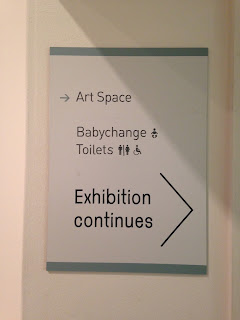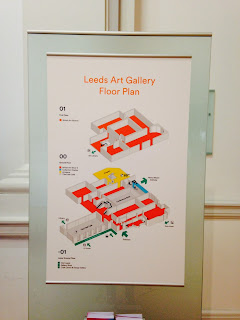For this brief we have to create a wayfinding and signage system for a chosen environment, this can be any area we chose and we can create it in any media we like. As i haven't actually heard of/designed a wayfinding system before my first idea was to google this and research into what i will be creating.
WAYFINDING
Wayfinding can be defined as spatial problem solving. It is knowing where you are in a building or an environment, knowing where your desired location is, and knowing how to get there from your present location. Wayfinding systems are created to inform peopler about the surrounding in a different environment they may not be familiar with, they show all the important information at the points they need to be shown to guide people.
effective wayfinding systems factors ;
don't make they audience think
are simple
don't cause any confusion
clear and consistent visual communication systems
convoy a important message/direction
remove excessive information/ only show whats needed
remove unnecessary elements to create understandable path way
create an identity at each location, different from all others
use landmarks to provide orientation cues and memorable location
create well-structured paths
create regions of differing visual character
don't give the user too many choices in navigation
provide signs at decision points to help wayfinding decisions
safely return back to the starting point
sources:
http://designworkplan.com/wayfinding/introduction.htm
http://www.ai.mit.edu/projects/infoarch/publications/mfoltz-thesis/node8.html
SIGNAGE
Signage systems are visually oriented information systems, consisting of signs, maps, arrows, color-codings systems, pictograms and different typographic elements. They are typically used to guide people's passage through the physical world; road signs on a highway, station identification signs in a– subway and overhead signs in an airport are all common examples of signage systems. The act of following a signage system is known as wayfinding, waysigning or signposting.
SIGNAGE IS THE IMAGER/TEXT, WAYFINDING IS FOLLOWING THIS SYSTEM
"where to locate signs, what they should say, and how they should say it”
This is quote talking about how to design a wayfinding system, its put is simplify and explains how the designer should go to the environment and think about the main key aspects of the design theory; where, what and how. these are the elements i need to take into consideration when creating my signs, i also have to think about how suitable they are for the audience, will the audience have a level of understanding or do they need to explain anything? what is the visual literacy of my audience? will there be able disable users? how will the audience seen the work? the more research i do into the signage design and how the systems work its clear that they are based completely around the audience and what will work best, the audience is the most important part because it has to be designed to work for them, not just look nice its created for a purpose to guide. Wayfinidng systems need to be simple to understand and quick to notice and read, they need to grab the attention of the view quickly then inform at a glance as they are walking past. They need to bring the complicated down so its simple and easy to understand, clarify the direction at the needed points not before or after.
secondary research examples
After my initial researching into way finding systems i can see that the designers can be creative with this simple concepts but this has to still include and be based around the main important information. The main focus always is the direction or the place, giving the audience a sense of guidance. All the different systems here use different medias and concepts but all work as they all inform the audience with the need information at the needed time, not before but when the decision about which direction to take is present. The design of all these unique systems is based around this idea that they interact with the view as they communicate a way with them, in all the main direction are seen clearly from afar, they are clear and mostly simple using symbols internationally recognized.
main features seen:
-bright colours used to catch attention
-bold clear fonts used to be clearly readable from a distance
-obvious from a glance what they all mean (clearly cognitive)
-less important information seen smaller
-use a constance house style on all floors, so it clear when on different floors where the direction are and the systems look the same throughout the environment
-not over complicated
-situated in places people look
-stand out
examples
This example is a clever way of creating a simple wayfinding system that uses the layout form of the rooms on each floor as a base for the floor number type. this look give a standing out appearance because it takes a clear and simple design but adds interest as well as content. Its aesthetically pleasing but also functional because the viewer can see where they are stood from a bird eye view, making the directions more relevant and giving them a sense of direction by basically giving them a map in a more simple form. the audience can clearly see which floor they are on as the designer has used a simple black type that is readable for almost any audience or any level, this is then contrasted as all the other elements which are white or brown, colours that clash with the main type body causing it to be the main focus.The floor number/current space should always be clear and obvious as this is the first part of information they need to know. The number is readable because of its larger bold text, its not overcomplicated or detailed which means it can be read from a distance which will also works for someone looking at a glance (as they past by) . Then the artist has created the layout of the rooms on the individual floor as the background, this raises the number slightly off the wall this emerged more attracting more attention to the wayfinding systems as its brought forward. Way finding systems always need to be recognizable because people will look for the same design every time they need a direction, the current house style here is kept all the same for each floor which means the audience will be able to recognise the direction from far and can clearly see they are the directions, a lost person cant get more lost looking for for a sign.
secondary research examples
After my initial researching into way finding systems i can see that the designers can be creative with this simple concepts but this has to still include and be based around the main important information. The main focus always is the direction or the place, giving the audience a sense of guidance. All the different systems here use different medias and concepts but all work as they all inform the audience with the need information at the needed time, not before but when the decision about which direction to take is present. The design of all these unique systems is based around this idea that they interact with the view as they communicate a way with them, in all the main direction are seen clearly from afar, they are clear and mostly simple using symbols internationally recognized.
main features seen:
-bright colours used to catch attention
-bold clear fonts used to be clearly readable from a distance
-obvious from a glance what they all mean (clearly cognitive)
-less important information seen smaller
-use a constance house style on all floors, so it clear when on different floors where the direction are and the systems look the same throughout the environment
-not over complicated
-situated in places people look
-stand out
examples
This example is a clever way of creating a simple wayfinding system that uses the layout form of the rooms on each floor as a base for the floor number type. this look give a standing out appearance because it takes a clear and simple design but adds interest as well as content. Its aesthetically pleasing but also functional because the viewer can see where they are stood from a bird eye view, making the directions more relevant and giving them a sense of direction by basically giving them a map in a more simple form. the audience can clearly see which floor they are on as the designer has used a simple black type that is readable for almost any audience or any level, this is then contrasted as all the other elements which are white or brown, colours that clash with the main type body causing it to be the main focus.The floor number/current space should always be clear and obvious as this is the first part of information they need to know. The number is readable because of its larger bold text, its not overcomplicated or detailed which means it can be read from a distance which will also works for someone looking at a glance (as they past by) . Then the artist has created the layout of the rooms on the individual floor as the background, this raises the number slightly off the wall this emerged more attracting more attention to the wayfinding systems as its brought forward. Way finding systems always need to be recognizable because people will look for the same design every time they need a direction, the current house style here is kept all the same for each floor which means the audience will be able to recognise the direction from far and can clearly see they are the directions, a lost person cant get more lost looking for for a sign.
primary research examples
HENRY MOORE INSTITUTE
LEEDS ART GALLERY
BRITISH ART SHOW 8
TRINITY SHOOPING CENTER
HENRY MOORE INSTITUTE
LEEDS ART GALLERY
BRITISH ART SHOW 8
TRINITY SHOOPING CENTER










































No comments:
Post a Comment